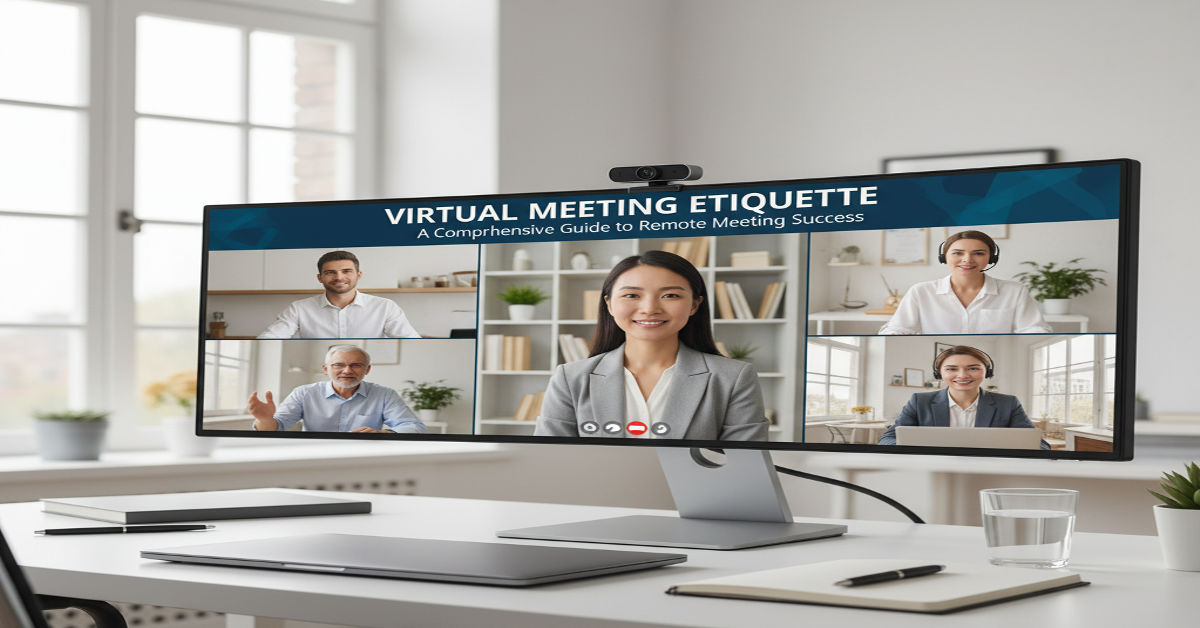As hybrid and remote work models become increasingly common, the art of conducting and participating in virtual meetings has become a critical skill. Bringing people together behind screens demands more than just turning on your camera it requires deliberate attention to professionalism, clarity and respect. Thoughtful virtual meeting etiquette bridges the gap between physical presence and remote collaboration—ensuring your message lands, your team remains engaged and the meeting time is well spent.
In this guide, you will discover how to prepare, present, lead, include and troubleshoot virtual meetings with confidence. Each section offers actionable advice, real-world context and practical checklists that you can adopt immediately. By internalizing these norms, you will not only enhance your own credibility but also contribute to a culture of respect, productivity, and engagement in online collaboration.
Why Virtual Meeting Etiquette Matters
Even though participants are not physically gathered in the same room, the same principles of respect, clarity, and engagement apply in virtual meetings. Poor audio, interruptions, or multitasking can erode attention and morale. Research indicates that virtual meeting behaviors—such as equitable speaking time and minimizing interruptions—strongly affect how inclusive and effective the meeting feels (pmc.ncbi.nlm.nih.gov).
Moreover, virtual interaction tends to amplify small missteps: a microphone left unmuted, video lag, or a participant talking over someone due to audio delay can derail momentum. Strong etiquette helps mitigate those friction points. The result is meetings where ideas are heard, time is respected, and participants feel valued.
Preparing for the Virtual Meeting
Preparation is the foundation of any effective meeting. Whether hosting or attending, a few thoughtful actions before the session begins can transform the experience from chaotic to professional. Circulate a clear agenda at least 24 hours in advance. Include the meeting purpose, topics, time allocations, and any required pre-reading. Doing so ensures everyone arrives informed and ready to contribute meaningfully.
Equally important is role assignment. Clarify who will facilitate, present, take notes, or manage technical issues. This structure avoids confusion once the meeting begins. Encourage participants to test their camera, microphone, and internet connection before joining. Preparation demonstrates respect for others’ time and helps keep the meeting productive.
| Task | Action | Purpose |
| Agenda | Send at least 24 hours prior | Keeps everyone aligned and ready |
| Role assignment | Clarify facilitator, note-taker, presenters | Prevents confusion |
| Tech check | Test camera, mic, internet | Ensures smooth participation |
| File readiness | Open documents needed for screen sharing | Reduces fumbling during meeting |
| Quiet space | Choose distraction-free environment | Maintains focus and professionalism |
Setting the Scene: Environment & Appearance
How you appear and sound on camera shapes how others perceive you. A clean, well-lit, and composed setup signals professionalism. Choose a background that’s tidy and uncluttered—if not possible, use a subtle blur or neutral virtual background. Position your camera at eye level so you appear natural and engaged.
Lighting and sound are equally critical. Light your face from the front or side (never from behind) to avoid shadows. Use a dedicated microphone or headset for crisp audio and fewer interruptions. Before joining, silence notifications and close unrelated apps. These seemingly small steps ensure participants focus on your words not distractions.
| Component | Ideal Practice | Benefit |
| Background | Simple, uncluttered, or blurred | Reduces distraction |
| Camera angle | Eye-level framing | Enhances connection |
| Lighting | Soft, front-facing light | Keeps face visible |
| Audio | Quality headset or mic | Improves clarity |
| Noise | Quiet space, mute when not speaking | Prevents interruptions |
| Visual presence | Dress professionally | Builds credibility |
Technical Readiness: Tools, Internet & Backup Plans
Technical readiness distinguishes a smooth, professional meeting from one riddled with frustration. Use a reliable platform that all participants are comfortable navigating. Confirm access links, permissions, and settings before the session. Test breakout rooms, polls, or shared screens if you plan to use them.
Next, focus on stability. Whenever possible, use a wired internet connection. Keep a backup plan ready—a dial-in number or alternative platform can save the day if technical difficulties strike. Also, ensure you know how to adjust audio, mute others, or share documents efficiently. These precautions protect both your reputation and your meeting’s flow.
Joining and Starting the Meeting: Best Practices
The first minutes of a meeting define its tone. Joining a few minutes early shows preparedness and respect for others’ time. It also lets you troubleshoot technical issues quietly before others join.
If you’re hosting, welcome attendees warmly, review the agenda, and explain how to engage (using chat, reactions, or hand raises). Clearly state whether the meeting is being recorded. Small touches like acknowledging early joiners or greeting participants by name foster inclusivity from the outset.
| Step | Best Practice | Why It Matters |
| Join early | 3–5 minutes before start | Allows time for checks |
| Greeting | Welcome and acknowledge attendees | Sets a positive tone |
| Agenda review | Reiterate key objectives | Keeps focus clear |
| Ground rules | Clarify chat/mute/raise-hand norms | Ensures orderliness |
| Recording notice | State if session is recorded | Builds transparency |
During the Meeting: Behavioural Guidelines for Participants
During virtual meetings, attentiveness and respect define professionalism. Avoid multitasking—switching tabs or checking phones signals disinterest. Keep your camera on when possible, maintain eye contact, and show engagement through nods or brief verbal affirmations.
Communication should be deliberate and courteous. Mute your mic when silent and unmute only when ready to speak. Pause before talking to avoid overlap due to lag. Use chat or raise-hand features to indicate you’d like to contribute. These behaviors ensure orderly discussions and a sense of fairness.
| Behavior | Recommended Action | Positive Outcome |
| Camera use | Keep on when feasible | Builds connection |
| Muting | Stay muted when silent | Reduces background noise |
| Speaking | Pause briefly before speaking | Prevents interruptions |
| Listening | Face the camera, avoid distractions | Shows attentiveness |
| Chat use | Keep messages relevant and brief | Keeps focus on topic |
Leading the Meeting: Host Responsibilities & Norms
A great host ensures structure, inclusivity, and efficiency. Begin by restating goals and assigning time limits to agenda points. Guide the conversation, invite quieter participants to speak, and manage the chat. Stay vigilant for dominant voices or tangents that consume time.
As the meeting closes, summarize decisions, next steps, and responsible parties. Express appreciation for participation—it strengthens team culture and accountability.
| Role | Key Action | Impact |
| Timekeeper | Track schedule and prompt transitions | Keeps meeting efficient |
| Moderator | Manage chat, mute/unmute when necessary | Maintains flow |
| Engagement leader | Encourage quieter members | Ensures inclusivity |
| Summarizer | Recap key decisions and next steps | Strengthens alignment |
| Follow-up sender | Share summary email or minutes | Reinforces accountability |
Inclusive and Respectful Practices in Virtual Meetings
Inclusivity transforms meetings into spaces where every participant feels valued. Use round-robin discussions, polls, or chat prompts to encourage diverse input. Rotate facilitation roles to avoid dominance by a few voices. Research supports that structured inclusion enhances engagement (arxiv.org).
Consider cultural and time-zone differences too. Rotate meeting times fairly and share agendas or recordings for those unable to attend live. Speak clearly and avoid idioms that might confuse non-native speakers. Respect differences in communication style and comfort with video.
| Context | Practice | Benefit |
| Diverse teams | Use structured turns and prompts | Promotes equal voice |
| Global teams | Rotate inconvenient time slots | Ensures fairness |
| Language variety | Speak slowly, avoid slang | Enhances understanding |
| Accessibility | Offer captions or transcripts | Expands participation |
| Hybrid format | Acknowledge remote attendees frequently | Prevents exclusion |
Troubleshooting Common Issues
Despite preparation, technical or behavioral issues may arise. The key is swift, calm resolution. If audio fails, suggest switching to phone or chat. For lag, turn off video temporarily. If discussions derail, politely steer them back on track.
When participants dominate or interrupt, acknowledge their input and redirect. Consistent facilitation keeps everyone engaged and respectful.
Virtual Meeting Etiquette for Hybrid and Global Teams
Hybrid meetings blend in-person and remote dynamics, making inclusivity more challenging. Ensure cameras show everyone physically present and microphones capture all voices clearly. In-room attendees should look toward the camera when speaking so remote colleagues feel part of the discussion.
For global teams, distribute materials early to accommodate different time zones. Allow asynchronous input through shared documents or recorded comments. Use empathy as your compass—acknowledging diverse realities builds stronger, more cohesive teams.
Conclusion & Call to Action
Virtual meeting etiquette is a modern professional’s soft power. When practiced consistently, it ensures clarity, respect and productive collaboration. Whether you’re a participant or host, these habits cultivate connection across digital distance.
Start applying them today prepare thoughtfully, engage attentively, and lead inclusively Virtual Meeting Etiquette. Share this guide with your team to standardize your approach and elevate your online professionalism. Let every virtual meeting become an opportunity for impact—not fatigue.
FAQ
Q1: Should I always keep my video on during virtual meetings?
Video is highly recommended because it enhances connection, trust, and accountability. But bandwidth constraints, camera fatigue, or situational discomfort are valid exceptions. When video is off, verbally acknowledge your presence and stay actively engaged.
Q2: What do I do if the meeting is recorded and I’m uncomfortable with that?
Ask upfront about recording and how it will be used or shared. If needed, request that your video or contributions not be recorded or suggest anonymized or consent-based recording.
Q3: How long should a virtual meeting last for best engagement?
Aim for 30–45 minutes whenever possible. Virtual fatigue sets in faster than in-person. If more time is required, schedule a break or split into multiple focused sessions.
Q4: How can I help quieter participants speak up?
Use structured turns, name invitations, breakout rooms, or chat prompts. Rotate speaking roles across meetings. Actively ask for views from less vocal members, giving them space and encouragement.
Q5: Is multitasking ever acceptable in a virtual meeting?
Generally no—multitasking diminishes your attention and basic courtesy to others. Exceptions might be minimal note taking or referencing documents. Minimize distractions so your primary focus remains on the meeting.







